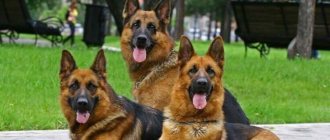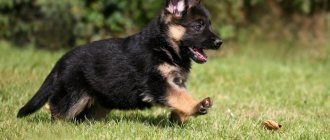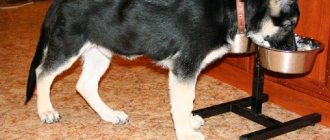Almost every child growing up in the 90s dreamed of finding such a loyal and intelligent friend as a German shepherd.
The series “Commissioner Rex,” which was popular in those days, did its job - there was an unprecedented peak in the popularity of the breed.
Many years have passed since then, but a German Shepherd puppy remains a desirable pet for many.
And before making this dream come true, it is worth understanding the intricacies of keeping, raising and feeding this creature.
Appearance and photo of a two-month-old puppy
Up to 3 months, all young shepherd dogs have the same black-brown coloring, but closer to this age, some of them develop whitish spots, which is a sign of “marriage.” At 2 months, the dog rapidly gains height and weight. The color of the coat becomes clearer, and the paws become wider and longer.
A purebred German Shepherd puppy looks like this: strong paws, a slightly hump nose, almond-shaped brown eyes. When the dog turns its head, you can notice the white of its eye. At this moment, her gaze resembles a human one.
Description of the German Shepherd breed
The German Shepherd as a breed appeared in Germany at the end of the 19th century. The dogs are large, weighing up to 40 kg for males and 32 kg for females. The height at the withers of an adult male is 65 cm, the female is 5-7 cm lower. The dogs are built harmoniously and proportionally, their body is slightly elongated, muscular, strong, and their bones are not rough. The head is wedge-shaped, moderately wide in the area of the ears. The forehead is convex, the stop is smooth. The neck is mobile, strong and graceful. The eyes are dark, oval and slightly slanted. The jaws are well developed, the teeth are strong, and the bite is scissor-type. The ears are large, erect, directed forward. The chest is voluminous, the back line is flat, with a slight slope from the withers to the croup. The tail is lowered, slightly curved, long. The limbs are straight, strong, parallel.
The coat is thick, dense, with high-quality undercoat. Color black, tan, zoned grey. The German Shepherd has a dark mask on its face and a saddle cloth on its back.
The character of the German is friendly and lively. The intelligence is high, the breed is focused on serving people, it is easy to train and train.
Which food to choose: natural or dry
The owner of the dog is fully responsible for its condition, so one of his main concerns is the correct selection of balanced food. You can go two ways: buy factory-made food or create a menu for your pet from meat, vegetables and cereals.
Both feeding options have their supporters and opponents. Only experts can tell you what is best to stop at . But remember, the main task of nutrition is to provide the animal with the required amount of vitamins, microelements, proteins, fats and carbohydrates. If desired, this issue can be resolved by having any type of food available.
Feeding with natural products
Preparing such a diet takes a lot of effort and time, however, according to experienced dog breeders, the result meets expectations.
Positive and negative sides
Dog breeders who choose a natural diet motivate their opinion as follows:
- meat is a product that animals eat in nature;
- there is an opportunity to choose the products yourself, without doubting that they are fresh and of high quality;
- when the owner himself creates a diet for a pet, he does not include allergenic substances in it.
But here's what fans of industrial feed say:
- It will take a lot of time to prepare natural food, and it simply won’t be enough to walk and train the animal;
- not every person knows exactly how many calories are enough and what portions are needed to fully feed a particular dog;
- high quality products are very expensive.
According to veterinarians, if a puppy is fed artificially, you should not immediately switch it to a natural diet, and vice versa.
This is harmful to his health, as is combining the two types of food.
Basic Rules
Before getting a puppy, the owner must accept the fact that training a dog is an integral event that can be compared to attending a kindergarten or school. Training is important not only for the dog, but also for the person, since an untrained dog can cause many problems.
Despite the fact that the German Shepherd is a naturally intelligent dog, it cannot become obedient and well-mannered on its own and will perform different actions due to the needs of the environment. The owner is obliged to teach his pet the key commands with which he can interact with his four-legged friend.
Even by training yourself, the dog owner will be able to correct the dog’s incorrect behavior and work on strengthening its developed abilities. During training, the teacher and his student learn to trust each other, understand and predict behavior. After some time, both sides will learn to understand each other almost on a telepathic level.
Some people mistakenly believe that training exhausts the animal. This is not true if you approach the process competently. With the right approach, “Germans” rejoice in new knowledge, because by learning, the dog fulfills its mission - to be useful to humans. This is fortunate for the German Shepherd, which was bred to serve people.
If the owner has never encountered the training of service dog breeds, he will need to use the help of a professional dog handler who will teach him how to properly handle the animal. An experienced training instructor knows all the characteristics of the breed, will explain the principle of training to a beginner and will help to get a well-mannered pet.
Understanding the principle of such a term, you can understand the meaning of training. After all, all training is based on reflexes.
There are two types of reflexes: unconditioned and conditioned.
The first option is the animal’s innate reactions. Here you can place security, hunting instincts, food, sexual, defensive reactions. When teaching new skills, the trainer will use the food reflex, rewarding his student for correctly completing the task.
If the animal's guard and defensive reflexes are well developed, this is also taken into account. Such representatives successfully demonstrate themselves in the protective guard service
Conditioned reflexes are usually called reactions that a dog acquires throughout its life. In simple terms, this is the relationship that is created in the dog’s head while working with a person. When the owner rewards his pet for correctly completing a task, the reflex will look like this: completion of the task - goodies - pleasure. Reflexes also work in the opposite direction. Incorrect behavior results in punishment, which causes discomfort in the animal.
Any training, even initial training, is based on the use of unconditioned reflexes to develop conditioned ones. Puppies, who have innate food reflexes, will try to get a treat from their owner's hands by following directions. The trainer teaches the pet a certain skill, using food as motivation. By treating the dog, he develops conditioned reflexes in it.
Having settled a small puppy in your home, you need to remember that in the future the baby should become a well-mannered dog. To achieve good results, you should remember three rules.
- Discipline. Many owners make concessions to their little friends and allow them more than they should. This should not be done, since each action must be modeled on an adult dog. If a small puppy lies cutely on the sofa, then an adult dog will not cause delight and tenderness in every person. What is not allowed for an adult dog should not be allowed for a small one.
- Encouragement. You need to treat your baby with care and guide him, praise him for correctly performed actions. There is no need to be strict. It is best to teach commands in the form of games. An animal feels everything like a child. Therefore, you need to praise your four-legged friend for going to the toilet in the right place, when he succeeds in the team, after eating.
- Schedule. Feeding should be done at the same time and only from a bowl. The dog must have its own place to eat. This mode will make life easier in the future, since you will not need to collect leftover food throughout the house.
Required Products
Owners can use their culinary imagination to feed their pet. We list the most common dishes for German Shepherd puppies:
- chicken fillet, rolled oats and stewed vegetables;
- grated apple with fermented baked milk;
- veal with rice and butter;
- baked pumpkin with chicken hearts;
- biscuits with curdled milk;
- boiled boneless chicken with buckwheat porridge and vegetables;
- carrot salad with chicken liver and sour cream;
- oatmeal with egg and beef.
What products are unacceptable?
Please note that the following components should not be included in your pet's diet:
- bread and all flour products;
- fatty fish and meat;
- confectionery;
- berries and fruits with seeds;
- legumes;
- sausage;
- bones;
- any seasonings.
Dogs, like people, have a weakened immune system during the cold season. To strengthen it, it is advisable to contact a veterinarian, who will advise what exactly to feed the puppy during these periods.
How many months should ears stand?
Small puppies' ears look disproportionately large. From 2 months to 4 months of age, the German Shepherd's body actively produces elastin and collagen, so the ears grow much faster than other parts of the body. They become heavy and large. From two to six months they begin to stand up - first in a “house”, “cap”, they can fall to one side, rise and fall again. By 5 months of age, the structure of the auricle reaches its maximum density, the ear stops growing and stands up completely. If this does not happen, the reason may be:
- lack of minerals in the diet;
- ear pathologies;
- weak immunity;
- the shepherd is not purebred;
- individual characteristics of the puppy.
Advantages and disadvantages of dry food
It is beneficial to keep puppies on dry food because:
- As a rule, the composition of the food is suitable for the dog’s age and physical parameters;
- no need to spend a lot of time preparing food;
- factory products are easily stored.
But we must not forget that:
- good food cannot be cheap;
- economical options contain few nutrients, which is harmful for the dog;
- components of the food sometimes cause allergies in the animal, and then you will have to look for a more suitable option.
Raising a fighter
You should start training your dog as early as possible. Although puppies may seem like touching bear cubs, they can easily force you to obey. After the first vaccinations, they are accustomed to the street and a leash. At two months they are only introduced to the street and taken out only once or twice for 5-10 minutes. A one-year-old dog should spend half an hour in the fresh air twice a day.
On walks, it is better to take playing equipment with you; it is better if the dog carries it himself: in his teeth or in a special backpack on his back.
You need to train your dog strictly and confidently: punishments must be timely, and indulgences must not be allowed. One method of punishment is to lightly press the dog's muzzle to the floor and gaze intently into the eyes. If, in a fit of play, an animal hurts, you need to shout out loudly, and then leave the animal, do not talk or approach it for a while.
Channel member Irina Bezuglaya will talk about dog training in her video, which we recommend watching.
Pets of this breed are very smart and capable of serving as a guard, but even without special training, the dog will definitely stand up for the owner. If you understand that you are not ready to devote enough time to training, it is better to give the animal for training to an experienced dog handler.
For those who do not know how to care for such a pet, you just need to know that in this regard, the breed does not require any specific knowledge. The pet's fur should be combed, nails trimmed as they grow, the dog should be regularly checked after a walk for ticks, and treated for all parasites. The dog must be accustomed to these procedures from childhood and endure them unquestioningly - and then caring for the puppy will be a joy for both you and him.
Selection rules
We can safely say about dog food that the price corresponds to the quality. There are 4 groups of factory products for puppies:
- Economy There are no advantages in this category other than cheapness. The raw materials for cooking are meat, vegetable and cereal waste. The caloric content and nutritional value of such food are extremely low.
- Premium . The basis of the feed is cereals and by-products. They are often combined with flavorings and flavor enhancers.
- Superpremium . This category is recommended by both veterinarians and dog breeders. It has a balanced composition and the absence of allergens.
- Holistic . The best quality, and therefore most expensive, food. In addition to nutrients, they contain a vitamin complex, thanks to which the dog will not lack useful elements in the body.
Lifespan
With proper care, the dog lives from 10 to 15 years. Health and illness
The German Shepherd is a non-capricious animal regarding diseases. However, the breed is prone to genetic diseases such as:
- Hip dysplasia. It appears mainly in older dogs. Symptoms: drowsiness and lethargy of the pet, lameness. The course of treatment is prescribed depending on the degree of looseness of the joints of the limb.
- Myocardial disease. Dogs aged 5 years and older are at risk. The development of the disease is provoked by the presence of infection in the body, lack of physical activity or insufficient amount of it. Symptoms: respiratory failure, shortness of breath, apathy and cough.
- Inflammation of the organs of the endocrine system. Germans are prone to pancreatitis and other possible inflammations in this area of the digestive system. Signs: sudden weight loss in the dog, chronic stomach upset, hair loss and growth retardation. The doctor prescribes medications for the animal to maintain the level of enzymes in the blood that the damaged gland produces, and vitamins.
- AD (Atopic dermatitis or eczema) is a skin disease in the form of an allergic reaction. The causes of the disease include dust mites, fungus, medications, and contact with another infected dog. Treatment is carried out using antihistamines.
- Falling disease (epilepsy). Consequences of past infections, insect bites, damage to the body’s central nervous system. It manifests itself in the animal’s restless behavior, convulsions, incontinence and increased salivation. Unfortunately, this disease has no cure. All the owner can do is keep the dog in a neutral position.
- Inflammation of the bone substance (panostitis). The risk zone includes babies under one year old. The disease is characterized by inflammation of the tubular bone, where bone marrow is replaced by fibrous tissue. Characteristic signs: lameness, hunger strike, weight loss. Eosinophilic panostitis is treated with painkillers and anti-inflammatory drugs.
- Hemophilia. It is transmitted to puppies from a sick mother or father. Symptoms: spontaneous appearance of bruises, poor blood clotting, swelling of muscle tissue. The owner protects such animals from any bruises and injuries, because the dog can die even from a minor wound. The disease cannot be treated. The blood is stopped by transfusion.
Required vaccinations for 2 month old dogs
At this age, German Shepherd puppies must be vaccinated against distemper and parovirus enteritis. To achieve the desired effect, the vaccination is repeated after 2-3 weeks.
There are 3 vaccine options with different rates of developing immunity to diseases:
- Nobivak – 10 days;
- Erican – 14 days;
- Kanigen, Vanguard, Duramun - 21 days.
At the end of the specified period, the animal can walk among other dogs and participate in competitions.
Table of development and weight up to one year
What to feed a German Shepherd puppy at home
The first year of life and development is important not only for a shepherd dog, but for any dog, regardless of whether it is a purebred dog or not. In the first months, the formation of the central nervous system occurs. Closer to a year, the animal goes through the stage of adolescence. Even if the pet looks already fully formed, this period will end only by 2 years.
Until the age of 1 year, it is very important to monitor the condition, weight and general development of the baby. Any deviation from the norm is a cause for concern and adjustments in nutrition and maintenance.
The table for the development and weight of a shepherd dog is as follows:
| Age in months | Height in cm | Male weight in kg | Female weight in kg | Chest circumference in cm |
| 1 | 19-22 | 3,3-4 | 3-3,4 | 28-32 |
| 2 | 32-41 | 8,5-9 | 7-8 | 45-51 |
| 3 | 41-47 | 14-15 | 11-12 | 55-59 |
| 4 | 48-57 | 19-20 | 16-16,5 | 60-65 |
| 5 | 50-58 | 22-23 | 20-21 | 66-70 |
| 6 | 52-60 | 24-26 | 22-23 | 69-72 |
| 7 | 53-63 | 28-28,5 | 23-24,5 | 71-72 |
| 8 | 53-63 | 28-30 | 26-27,5 | 72-74 |
| 9 | 53-63 | 30,5-32 | 28-29 | 74-75 |
| 10 | 54-65 | 32,1-33 | 28-29,5 | 75-77 |
| 11 | 54-65 | 33-34 | 28-29,6 | 76-77 |
| 12 | 55-67 | 34-35 | 30-32 | 76-78 |
How to care for a two month old puppy
At 2 months, your pet will have to endure a lot of stress: being separated from its mother, moving to another place of residence, changing its diet, going to the veterinarian. In order for the dog to better adapt to these processes, it needs to create appropriate living conditions and observe all the subtleties of caring for the puppy.
Personal sleeping area
If you need a shepherd dog for security purposes, it needs to be placed in an enclosure where there is a warm, comfortable booth. The floor inside is covered with straw, the ceiling is made very airtight to prevent precipitation from entering through it.
A place to sleep is of serious importance for an animal, so it is better to equip one booth for a long time. An already matured dog should be able to easily turn around in it.
If the pet will be kept in an apartment, he needs to lay a special mat-bed, away from heating devices and open windows. The corner should be secluded so that the puppy is not disturbed by the residents of the house.
Short story
Developed at the end of the 19th century, the breed became the “national dog” and a great source of pride in Germany. Germans are dogs that were originally used to guard farmsteads and sheep flocks. It is believed that the Germans originated through natural selection, from the wild wolves of India, having the blood of the shepherd-like Rudens, small agile and agile dogs.
However, until the beginning of the 19th century, there was an opinion among dog lovers that the Germans had no prospects - there were already a lot of herding dogs, and the Germans did not shine against the background of the same border collies or Australian shepherds. In 1898, officer and veterinarian Max Stefanitz was puzzled by the search for the ideal canine travel partner. At one of the exhibitions, Max found that same dog - the progenitor of modern BUT.
The first German dog had a motley color
A dog with an easy-going character, easy to train, agile and resilient, became the prototype of a new breed. From a male named Harand came three lines of Germans: zone, black and saddleback colors. Seven years later, the German Shepherd became the winner of a prestigious exhibition in Germany, and BUT became known all over the world.
These dogs were brought to Russia at the beginning of the 20th century, but because of the war, selection became impossible. Twenty years later, new stock was brought to our country from Germany, and domestic dog handlers have been working with dogs of these bloodlines ever since.
Hygiene rules
There are several procedures necessary for both children and adult shepherds:
- Combing wool. It is carried out 1-2 times a week to remove stuck together shreds and old undercoat.
- Bathing. Not done before vaccinations and during quarantine. The dog is washed a maximum of 3 times a year, but only in spring and summer. But the paws are wiped every day with a washcloth or wet towel.
- Cleaning your ears from dirt and wax 1-2 times a month. Until the ears have become stronger (up to six months), you need to touch the cartilage with extreme caution, otherwise the shells may grow incorrectly.
- Cleaning the eyes with special solutions that can be found in pet stores. This procedure is very important if the pet lives in the yard. The eyes should be clear without cloudiness, redness, or watery eyes.
- Brushing your teeth with chewing sticks or powder. This is necessary, since with a dry diet the risk of tartar formation is very high.
Non-standard colors
From time to time, puppies are born with deviations in color (blue, brown or white). These dogs are sterilized and given away as pets. Color should not be a reason for euthanasia.
White color
The partial albinism gene can be carried by a German Shepherd with a strong black coat and mask, but with sandy/gray tan markings. Sometimes such a dog produces fully or partially white puppies.
Considering that a small white spot can be found even on a dark wolf, such markings of a shepherd dog are often ignored (unless this sign extends). Pink claws on your fingers will also tell you about the manifestation of the white spotting gene.
Best articles: Difference between active volcanoes and dormant or extinct ones
Brindle color
This type of color is classified as extinct, although at one time (at the founding of the breed) it was almost the main one. The brindle gene is expressed on the tan area, causing black and tan shepherds to have black stripes/markings throughout the tan area (like brindle boxers). The color looks quite attractive, but so far not a single shepherd dog with a brindle zonal color has been presented to the field of view of dog handlers.
Blue and brown colors
Both options are not strictly prohibited, but they contradict the standard due to the incorrect coloring of the nose: in blue and liver shepherd dogs the nose is not black, but brown or gray. However, US breeders are increasingly trying to produce blue and brown "Germans" that have an impressive appearance (with 4 shades in both colors) with silver-yellow eyes.
With the blue gene, the black pigmentation changes to steel gray with the traditional tan color (sometimes with silver notes). With the liver color gene, the black pigment gives way to brown.
How to train a pet
It is the owner of the puppy who can teach him how to behave correctly around other animals and people. At the age of 2 months, you can already master basic commands. Remember a few simple rules, and your pet will grow up obedient.
How to teach to respond to a name
If the owner calls the puppy to him, plays with him, feeds him, gives him a toy, etc., he should always say the animal’s name. Over time, the dog gets used to the owner’s voice and develops a reflex to specific words.
Place training
In order for the puppy to remember where his corner is located, you need to use several simple techniques:
- Place your pet's favorite toy on the mat. He will remember where to go to play and will get used to this place;
- The dog needs to wake up where it falls asleep. However, the baby can get tired while playing and fall asleep anywhere, in which case he needs to be moved to a sleeping corner;
- The pet must be made to understand that he has a certain place. If he takes food or toys onto his bedding, it is unacceptable to take them away.
How to toilet train a puppy
Puppies up to 4-6 months do not control their natural instincts. But even at an early age, they can associate going to the toilet with going outside. 2-3 hours after sleep and the same time before, the owner should walk the dog.
If the puppy relieves himself outside, he needs to be praised and rewarded with treats. Then your pet will get used to coming to the door when he needs to go to the toilet.
The German Shepherd is a breed that can be used in many areas of our lives. She can become a policeman, a guide, a security guard, a border guard, or a shepherd. This is possible with the help of skills that this dog can learn thanks to its extraordinary intelligence. And in order for the puppy to develop in accordance with its high potential, pay attention to its upbringing and care from an early age.
Training
In addition to proper care and maintenance, a shepherd with dark hair must be trained and educated. It is necessary that it be exposed not only to physical, but also mental stress. After all, the breed was created for work. These are not ornamental animals. Such dogs serve their master well, guarding the house and yard.
Animals of this subspecies are easy to train
It is important to carry out regular training to keep your pet's brain constantly working. You can send your shepherd dog to guard duty courses and a general training course so that the dog can be taught by professionals. It is also necessary to remember that the pet must not only be obedient in front of the owner, but also behave with dignity in front of strangers
He must be socialized, that is, he must treat other animals and people normally
It is also necessary to remember that the pet must not only be obedient in front of the owner, but also behave with dignity in front of strangers. He must be socialized, that is, he must treat other animals and people normally.











